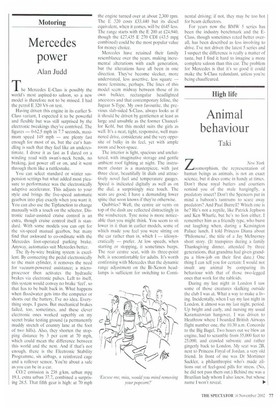Mercedes power
Alan Judd
The Mercedes E-Class is possibly the world's most aspired-to saloon, so a new model is therefore not to be missed. I had the petrol E 320 V6 on test.
Having driven this engine in its earlier SClass variant, I expected it to be powerful and flexible but was still surprised by the electronic tweakings they've contrived. The figures — 0-62.5 mph in 7.7 seconds, maximum speed 149 mph — are plenty fast enough for most of us, but the car's handling is such that they feel like an underestimate. I drove it as fast as I dared on a winding road with swan's-neck bends, no braking, just power off or on, and it went through them like a rattlesnake.
You can select standard or winter suspension settings but what added most pleasure to performance was the electronically adaptive accelerator. This adjusts to your style and brings the five-speed automatic gearbox into play exactly when you want it. You can also use the Tipfunction to change manually with a touch on the selector. Distronic radar-assisted cruise control is an extra, though cruise control itself is standard. With some models you can opt for the six-speed manual gearbox, but many find that awkward to co-ordinate with the Mercedes foot-operated parking brake. Anyway, automatics suit Mercedes better.
The fly-by-wire braking system is excellent. By connecting the pedal electronically to the main cylinder, it removes the need for vacuum-powered assistance; a microprocessor then activates the hydraulic brakes via electronic pulses. Left to itself, this system would convey no brake 'feel', so that has to be built back in. What happens when floodwater gets into the computer or shorts out the battery, I've no idea. Everything stops, I guess. But mechanical brakes failed, too, sometimes, and these clever electronic ones worked superbly on my secret brake testing ground (a permanently muddy stretch of country lane at the foot of two hills). Also, they shorten the stopping distance by 3 per cent at 70 mph, which could mean the difference between this world and the next. And if that's not enough, there is the Electronic Stability Programme, six airbags, a reinforced cage and a rollover sensor. You're about a safe as you can be in a car.
C0/2 emission is 238 gikm, urban mpg 19.1, extra urban 37.7, combined a surprising 28.5. That fifth gear is high: at 70 mph
the engine turned over at about 2,300 rpm. The E 320 costs £33,440 but its diesel equivalent, when it comes, will be £645 less. The range starts with the E 200 at £24,940, though the £27,435 E 270 CDI (43.5 mpg combined) could be the most popular value for money choice.
Mercedes have retained their family resemblance over the years, making incremental alterations with each generation, but the alterations have all been in one direction. They've become sleeker, more understated, less assertive, less square — more feminine, perhaps. The lines of this model seem midway between those of its own bulkier, rectangular headlighted ancestors and that contemporary feline, the Jaguar S-Type. My own favourite, the previous slab-sided S-Class, always looks as if it should he driven by gentlemen at least as large and unsubtle as the former Chancellor Kohl, hut this model suits the girls as well. It's a neat, tight, responsive, well mannered drive, considerate and the very opposite of bulky in its feel, yet with ample room and boot-space.
The interior is light, spacious and uncluttered, with imaginative storage and gentle ambient roof lighting at night. The instrument cluster is a masterpiece, with just three clear, beautifully lit dials and attractively novel fuel and temperature gauges. Speed is indicated digitally as well as on the dial, a surprisingly nice touch. The seats are good; I have a demanding lower spine that soon knows if they're otherwise.
Quibbles? Well, the centre air vents on top of the dash are reflected distractingly in the windscreen. Tyre noise is more noticeable than you might think. You seem to sit lower in it than in earlier models, some of which made you feel you were sitting on the car rather than in, which I — idiosyncratically — prefer. At low speeds, when starting or stopping, it sometimes burps. The rear centre seat, with its three-point belt, is uncomfortable for adults. It's worth confirming with Mercedes that the dynamic range adjustment on the Bi-Xenon headlamps is sufficient for switching to Conti nental driving; if not, they may be too hot for beam deflectors.
For years now the BMW 5 series has been the industry benchmark and the EClass, though sometimes rated better overall, has been described as less involving to drive. I've not driven the latest 5 series and I suspect the difference is really a matter of taste, but I find it hard to imagine a more complete saloon than this car. The problem for Mercedes is that it's so good it could make the S-Class redundant, unless you're being chauffeured.


























































































 Previous page
Previous page